Imagine a world where flowers do more than just beautify our gardens. From sunflowers that perform daily solar tracking to moonflowers that bloom under the cloak of night, the floral kingdom harbors secrets that are as intriguing as they are diverse. Consider the agave, which blooms once in its lifetime before bidding the world adieu, or the lotus flower’s remarkable ability to hibernate for years, only to re-emerge with the first kiss of moisture. These are not mere tales from the realm of fantasy but real, scientifically observed phenomena.
Dive into the vibrant world of botany with us as we explore fun facts about flowers, a journey that promises to enlighten even the most seasoned flower enthusiasts.
1. Starry Blooms of the Venus Flytrap
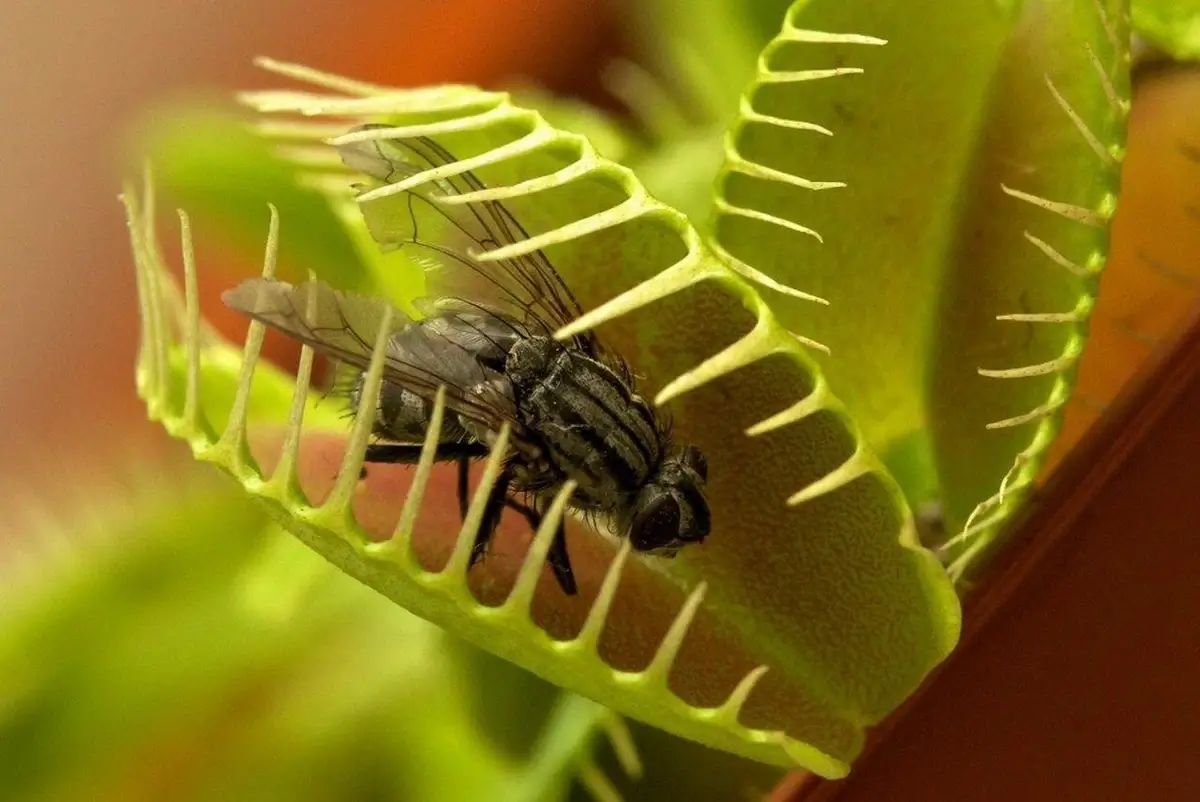
Image: X.com
Despite its fame as a carnivorous marvel, the Venus Flytrap (Dionaea muscipula) surprises many with its delicate flowering phase. Beyond its jaw-like traps that capture unsuspecting prey, this unique plant produces blooms that can only be described as celestial.
In spring, typically from May through June, the Venus Flytrap adorns itself with tiny white flowers, poised on stems high above the traps to avoid ensnaring the very pollinators it depends on. These flowers, resembling small white stars, offer a stark contrast to the plant’s predatory nature, showcasing its dual role in nature as both hunter and the hunted.
2. Agave’s Singular Bloom: A Life’s Grand Finale

Image: thelivingcoast.org
Agave plants, often mistaken for cacti, lead a life of quiet growth until they reach their spectacular and final act. Known for their rosette of thick, fleshy leaves, agaves are a dramatic example of monocarpic plants—those that flower once then die. But what a finale they present! The bloom is a towering stalk that can reach up to 35 feet, shooting up from the plant’s center and displaying a burst of flowers that attract a plethora of pollinators with their sweet nectar.
This blooming event is both a climax and a conclusion of the agave’s life, which can span from a decade to, in some cases, over 80 years depending on the species. The phenomenon is so rare and delayed that agaves are often called “century plants,” although this is a misnomer since they typically bloom much sooner. As the agave prepares for this ultimate effort, it directs all its stored energy into the bloom stalk, flowers, and subsequently, seeds or bulbils (baby plants), ensuring its legacy.
Once the flowering phase concludes, the plant’s lifecycle does as well. However, it leaves behind “pups” or bulbils, ready to grow into new agave plants, continuing the cycle of life.
3. Flowers Indicate Soil Properties

Image: facebook.com / Mon Jardin & Ma maison
Flowers like hydrangeas can serve as natural indicators of soil chemistry, particularly the pH level, which influences their color. For instance, hydrangeas display blue blossoms in acidic soil due to the availability of aluminum ions, essential for the blue pigment formation. Conversely, in alkaline conditions, these flowers turn pink or red, reflecting a lack of accessible aluminum for the plant.
This unique color-changing ability not only adds aesthetic diversity but also offers gardeners insight into their garden’s soil composition, guiding them in adjusting soil conditions or selecting compatible plant species for optimal growth.
4. Hydnora Africana: Nature’s Oddity

Image: gbif.org
The Hydnora africana is a unique plant native to South Africa, known for its striking resemblance to the “Piranha Plant” from the Mario video games. This parasitic plant lacks chlorophyll and instead relies on nearby plants for nutrients.
Its most notable feature is its flower, which emerges from the ground resembling a fungal entity rather than a typical plant. The flower emits a scent similar to feces to attract its primary pollinators, the Dermestes maculatus beetles, in a fascinating example of brood-site mimicry.
5. Lotus Flowers Can Hibernate

Lotus seed pod. Image: Maarten Heerlien / Flickr
The lotus flower, a symbol of purity, spiritual awakening, and eternity across various cultures, possesses a remarkable botanical feature: its seeds can lie dormant for thousands of years, only to bloom once they encounter water. This fascinating aspect of the lotus flower highlights its incredible resilience and adaptability, allowing it to survive in challenging environments and even through historical epochs.
The seeds of the lotus are encapsulated in a protective shell that enables them to withstand periods of extreme desiccation and later germinate with the presence of moisture, sometimes after centuries. This ability reflects not just a survival mechanism but also a metaphorical significance tied to rebirth and purity in various spiritual contexts.
6. Edible Flowers: Broccoli, Cauliflower, Artichokes

Broccoli growing in the garden. Image: gardeningknowhow.com
Surprisingly, some of the most common vegetables we consume daily are not vegetables at all, but flowers. Broccoli, cauliflower, and artichokes fall into this unique category, showcasing the fascinating intersection of culinary and botanical worlds.
Broccoli and cauliflower are the result of centuries of selective breeding from Brassica oleracea, known as wild cabbage. What we eat are the large, clustered flower buds developed through this process. Broccoli, known for its green heads, and cauliflower, typically recognized by its white heads, are actually clusters of unopened flower buds.
Artichokes present another intriguing case. These are the immature flower buds of Cynara scolymus, harvested before the flowers come to bloom. The part of the artichoke we eat consists of the bud that contains developing small flowers and specialized leaves called bracts. Cultivated for their flavor, artichokes are a culinary delicacy often compared to asparagus or celery in taste and are lauded for their fiber content and nutritional benefits.
The transition of these plants from wild species to cherished parts of our diet is a testament to the diversity and adaptability of edible plants. It highlights the intricate relationship between humans and the plant kingdom, where even flowers can become a central part of our meals.
7. Corpse Flower’s Massive Size and Scent

Amorphophallus titanum. Image: mirzhvetov.ru
The Corpse Flower, scientifically known as Amorphophallus titanum, is an astonishing plant known for its enormous size and the strong odor it emits, which resembles that of rotting flesh. This plant boasts the largest unbranched inflorescence in the plant kingdom, with blooms that can grow up to 8 feet tall. Its scent, which is most potent during its peak bloom at night into the early morning, is a strategy to attract pollinators like carrion beetles and flesh flies that are drawn to the smell of decaying material.
Native to the rainforests of Sumatra, Indonesia, the Corpse Flower is not only a botanical marvel but also a rare spectacle, blooming only once every few years to over a decade, making its flowering events a major attraction. Despite its infrequent blooming, the plant’s growth is rapid, peaking at a rate of up to 15 cm (6 inches) a day just before blooming, which lasts for about 24-48 hours. The bloom itself is a complex structure consisting of a spadix, surrounded by a spathe that opens to reveal a deep crimson to purple interior, emitting heat over 90°F (32°C) to help disperse its odor.
8. Fortune-Telling with Carnations in Korea
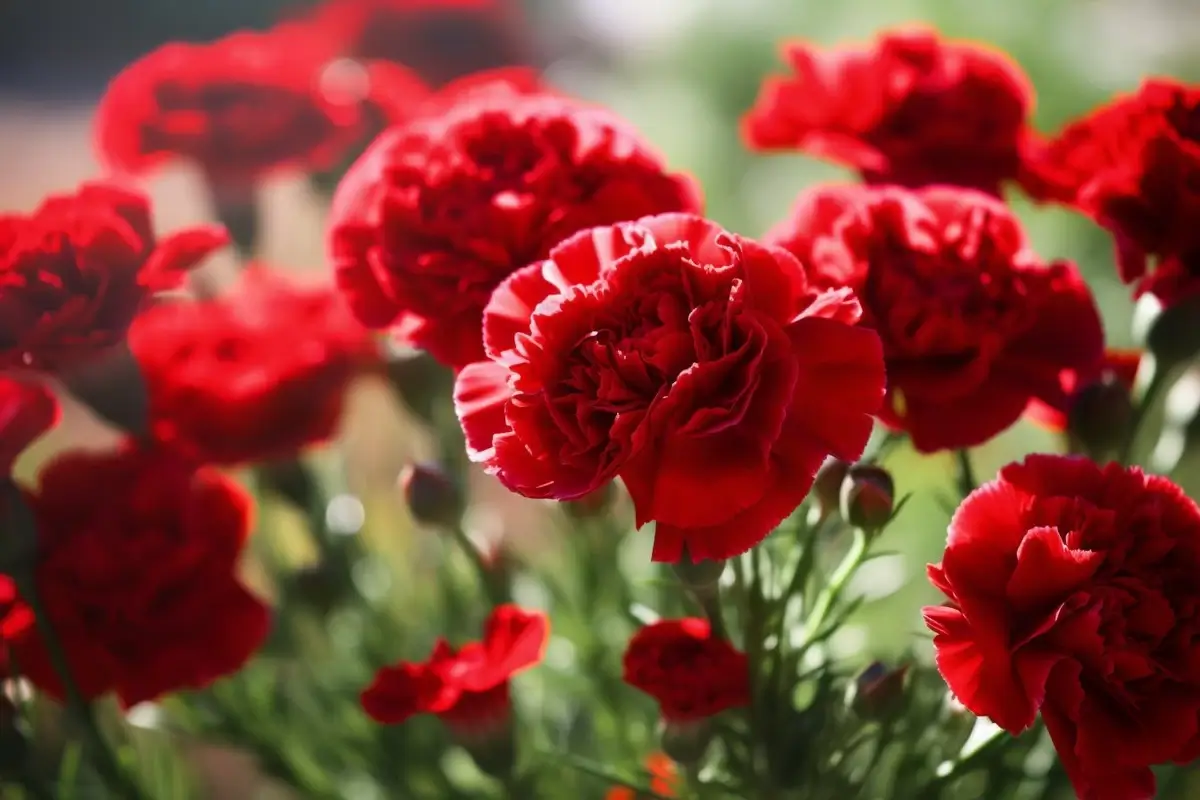
Red carnations growing in the garden. Image: foliagefriend.com
In Korean culture, carnations hold a unique place, not just as a symbol of love and admiration but also in the realm of fortune-telling. This practice, particularly involving red and pink carnations, is a traditional method used to predict a girl’s future. The ritual involves placing a cluster of three carnations in the girl’s hair. The order in which the flowers die is believed to foretell her life’s trajectory: if the top flower wilts first, her later years will be challenging; if the middle one dies first, her youth will be difficult; and if the bottom one withers away before the others, it signifies a life full of hardships.
Carnations, especially pink ones, are deeply symbolic, often associated with a mother’s undying love and widely recognized for blooming from the tears of the Virgin Mary. They carry meanings of love, fascination, and distinction, with each color conveying a different message — from deep love and admiration represented by red carnations to the expression of disappointment and rejection by yellow ones.
9. Juliet Rose, the £3 Million Rose – The Most Expensive Rose Developed

Image: Pinterest
The Juliet Rose stands as a pinnacle of horticultural achievement, not just for its breathtaking beauty but also for its astonishing price tag, making it the most expensive rose ever developed.
Conceived by the renowned rose breeder David Austin, the creation of this apricot-hued hybrid was a labor of love and dedication that spanned 15 years and cost £3 million (approximately $5 million). Its unveiling at the 2006 Chelsea Flower Show not only marked a significant milestone in the world of floriculture but also set a new benchmark for the value of a single flower species.
10. Lithops, or Flowering Stones: Nature’s Living Stone Mimics
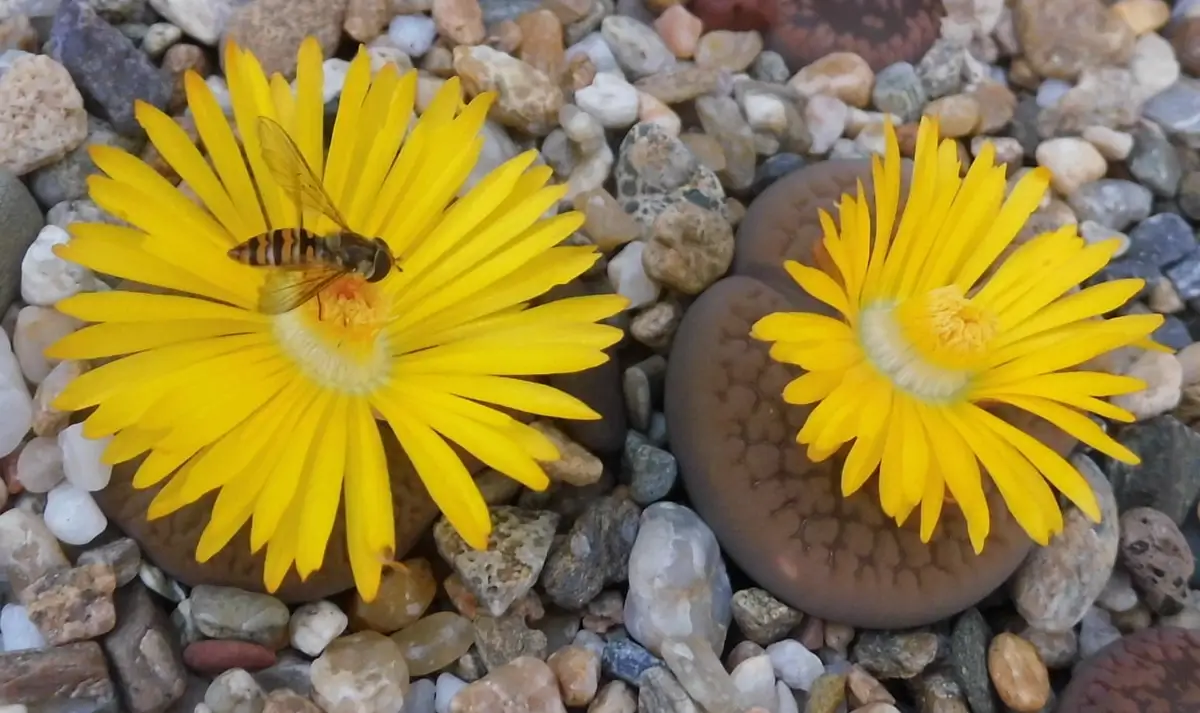
Image: candiru / Flickr
Lithops, commonly known as flowering stones or living stones, are a fascinating example of nature’s mimicry, blending seamlessly into their surroundings to evade predators. Native to southern Africa, these succulents have evolved to resemble the rocks among which they grow, a survival strategy to avoid being eaten in their arid habitats.
Their stone-like appearance is not just for camouflage; it also minimizes water loss, crucial in their desert environments. Lithops bloom with daisy-like flowers, emerging from between the two succulent leaves that make up the entirety of the plant. These blooms can be yellow, white, or orange and sometimes exceed the size of the plant itself, offering a stark contrast to their pebble-like façade.
11. Daisies Symbolize Innocence: Representing Purity and Light

Image: Tim Mossholder / Pexels
Daisies are universally cherished for their simple beauty and profound symbolism, representing purity, innocence, and the untainted joy of nature. These classic flowers, with their white petals radiating around a yellow center, carry a message of purity and innocence that has been recognized across cultures and ages.
The daisy’s association with innocence comes from an old Celtic legend, where it was believed that when an infant passed away, God sprinkled daisies over the earth to cheer the grieving parents. Furthermore, in Norse mythology, the daisy is connected to Freya, the goddess of love, beauty, and fertility, adding layers of meaning to its symbolism of purity and new beginnings.
12. Ghost Flower Lacks Chlorophyll

Image: mavink.com
The Ghost Flower, also known as Monotropa uniflora or Indian Pipe, is a remarkable plant that thrives in the absence of chlorophyll, the molecule essential for photosynthesis in most plants. This eerie, ethereal beauty is entirely white, from its petals to its stem, giving it a ghostly appearance that distinguishes it from its green peers.
Instead of drawing energy from the sun, the Ghost Flower is a mycoheterotroph; it siphons nutrients from a symbiotic relationship with fungi in the soil, which in turn are connected to the root systems of trees. This fascinating survival strategy allows it to live in dark, forested environments where sunlight is scarce.
The Ghost Flower’s unique lifecycle and its otherworldly appearance have made it a subject of intrigue and study, highlighting the incredible adaptability and diversity of plant life.
13. Moonflowers Bloom at Night
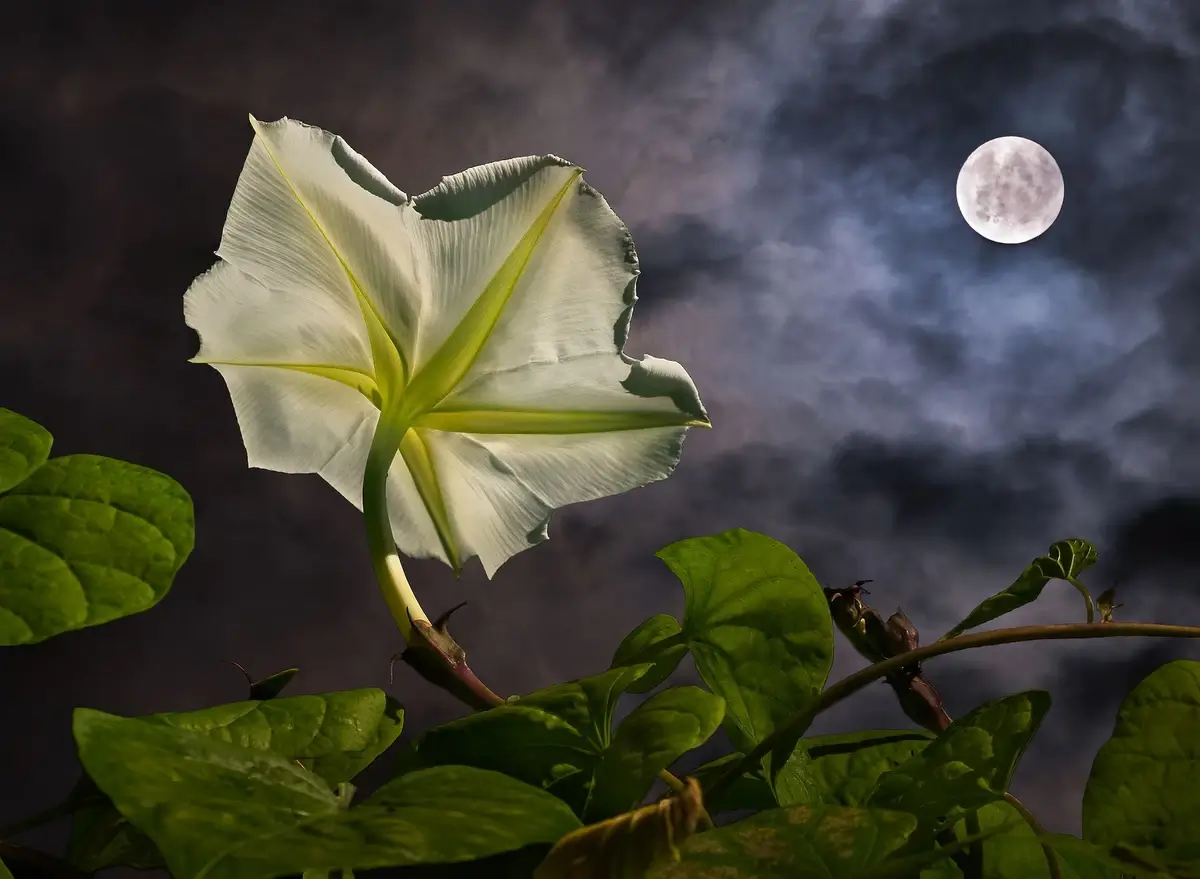
Image: Pinterest
Moonflowers (Ipomoea alba) are enchanting night bloomers, opening their large, fragrant flowers exclusively under the cloak of darkness.
Unlike most flowers that greet the sun, moonflowers unfurl their petals at dusk, showcasing their beauty to the nocturnal world and closing them again at sunrise. This unique blooming behavior aligns with the plant’s strategy to attract specific pollinators, such as moths and bats, that are active at night.
14. Serbian Phoenix Flower Revives with Water

Image: gesneriads.info
The Serbian Phoenix Flower, scientifically known as Ramonda serbica, is a testament to nature’s resilience and ingenuity. This remarkable plant, which is one of the few European representatives of the Gesneriaceae family, has the extraordinary ability to “resurrect” after being completely dehydrated. Found in specific regions of Serbia, such as the outskirts of Mt. Rtanj and Mt. Suva near Niš, Ramonda serbica thrives in cool, damp, and shaded environments, often on steep, north-facing limestone foundations.
The flower’s discovery by Serbian botanist Josif Pančić in 1874 near Niš marked the identification of a species with a unique survival mechanism. What makes this plant particularly fascinating is its capability, known scientifically as anabiosis, to return to life after enduring harsh conditions that would typically signify death for other species. This phenomenon was famously confirmed when a Russian botanist, in 1928, accidentally spilled water on a dried specimen, leading to its revival after a year and a half of desiccation.
15. Rhizanthella Orchid Blooms Underground
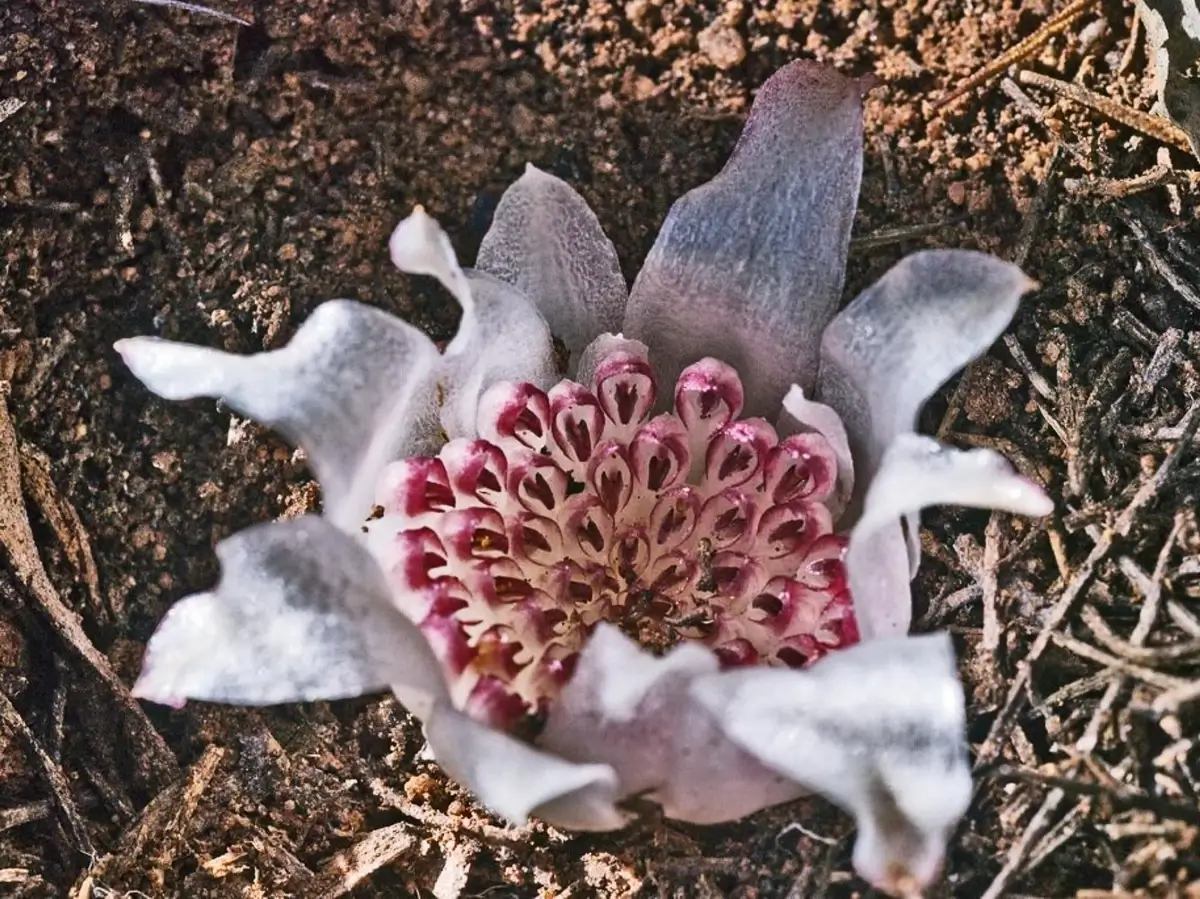
Image: Pinterest
The Rhizanthella orchid, a leafless and sympodial herb, is a marvel of nature that spends its entire lifecycle underground, including its flowering phase. This unique orchid produces up to 100 small, inward-facing flowers, pinkish to deep red and cream-colored, enveloped by pinkish-cream bracts that curve over, forming a tulip-like head. These bracts slightly open at the soil surface, allowing for a rare form of pollination that does not rely on the typical bee but possibly on termites, ants, and other soil-dwelling insects.
Discovered in 1928 by John Trott during ploughing operations on his farm near Corrigin, Western Australia, the Rhizanthella gardneri was so fascinating that a wax model of it toured around the British Isles. This underground orchid thrives in association with broombush species, obtaining energy and nutrients through a myco-heterotrophic relationship with mycorrhizal fungi.
The Rhizanthella orchid’s pollination mechanism remains largely a mystery, with only a single specimen of a small fly from the genus Megaselia, some small wasps, and termites observed carrying its pollinia. This underground life cycle and pollination strategy are so unique that they highlight the incredible diversity and adaptability of orchids.
Rhizanthella gardneri is critically endangered, known only from a few locations in Western Australia. Its survival is threatened by habitat loss due to agriculture, drought, and rising soil salinity. Efforts are underway to conserve and understand more about this extraordinary plant, including seed-banking and DNA fingerprinting initiatives by partnerships between various conservation organizations.
16. Rainbow Rose’s Unique Colors

Image: thespruce.com
Rainbow Roses are a stunning floral creation where each petal displays the vibrant colors of the rainbow. Unlike natural blooms, these roses undergo a special dyeing process to achieve their spectacular appearance. The “Vendela” rose, a cream-colored Hybrid Tea cultivated in the Netherlands, Colombia, and Ecuador, is commonly used for this process due to its perfect dye absorption capabilities. The rose’s stem is split and each part is dipped into differently colored water, allowing the colors to be drawn up into the petals, creating a mesmerizing rainbow effect.
This process capitalizes on the rose’s natural capillary action, where the xylem tubes within the stem transport water to the petals. When the petals absorb the colored water, the water eventually evaporates, leaving behind the vibrant dye colors. This method works best with white or light-colored roses such as pale pink, yellow, or cream, and while a variety of color combinations are possible, black and white cannot be achieved.
Despite their beauty, rainbow roses do not last as long as their naturally colored counterparts due to the dye affecting their ability to photosynthesize and survive. Those interested in creating their own rainbow roses at home can do so by carefully splitting the rose stem into sections and immersing each section in water dyed with food coloring. It’s a delicate process that requires patience, as the colors begin to show as early as 30 minutes after the setup, but achieving vibrant colors may take up to a week.
17. Shenzhen Nongke Orchid: The World’s Most Expensive Flower

Image: wallsdesk.com
The Shenzhen Nongke Orchid, cultivated by researchers at Shenzhen Nongke University in China, is an extraordinary example of scientific achievement in botany. This man-made orchid, which took nearly eight years to develop, is renowned not only for its stunning appearance but also for its rarity and the meticulous care it requires.
Remarkably, it blooms just once every four to five years, with each flower lasting for about six weeks. In 2005, it set a record by being sold at auction for an astounding $200,000, making it the most expensive flower ever sold.
18. Tallest Sunflower Recorded

Image: abc7chicago.com
The world record for the tallest sunflower ever grown is held by Hans-Peter Schiffer of Germany. This sunflower reached an astonishing height of 9.17 meters (30 feet 1 inch), as verified on August 28, 2014, in Kaarst, Nordrhein Westfalen, Germany.
Schiffer is no stranger to growing towering sunflowers, having previously held the record twice before this achievement. The cultivation of such a colossal plant underscores the potential of sunflowers to grow far beyond their common size under ideal conditions.
19. Naked Man Orchid’s Unique Petals

Image: Pinterest
The Naked Man Orchid (Orchis italica), native to the Mediterranean Basin, is an orchid species famed for its distinctive bloom that closely resembles a naked man. The flower’s medium petal, known as the lip or labellum, undergoes modification to mimic the shape of a man, complete with limbs and, intriguingly, genitalia, giving rise to its common name. This unique floral mimicry not only captivates onlookers but also serves as a fascinating study in the adaptive evolution of plant species to attract pollinators.
Found across the Mediterranean, from the Balearic Islands and southern Europe to parts of western Asia and northern Africa, Orchis italica thrives in partial shade and low-nutrient soil, blooming in April. Despite its rarity, the orchid is listed as a species of “Least Concern” by conservation authorities, suggesting a stable population for now. However, its specialized habitat makes it vulnerable to environmental changes.
20. Puya Raimondii’s Rare Blooming

Image: researchgate.net
The Puya Raimondii, known as the Queen of the Andes, is the world’s largest bromeliad, found in the high Andes of Bolivia and Peru. This spectacular plant can reach up to 15 meters (50 feet) in height, with a rosette of about two hundred leaves and an inflorescence that measures between 4 to 8 meters (13 to 26 feet) tall. A single plant can produce between 8,000 and 20,000 flowers over a three-month period.
Remarkably, its reproductive cycle spans approximately 80 years, though instances in controlled environments like the University of California Botanical Garden have seen blooms after just 28 years. The Puya Raimondii is semelparous, meaning it dies after flowering once. This rare event attracts pollinating birds, and despite its imposing appearance, it is considered endangered due to threats like human-caused fires, climate change, and declining genetic diversity.
21. Angelica’s Supposed Angelic Powers
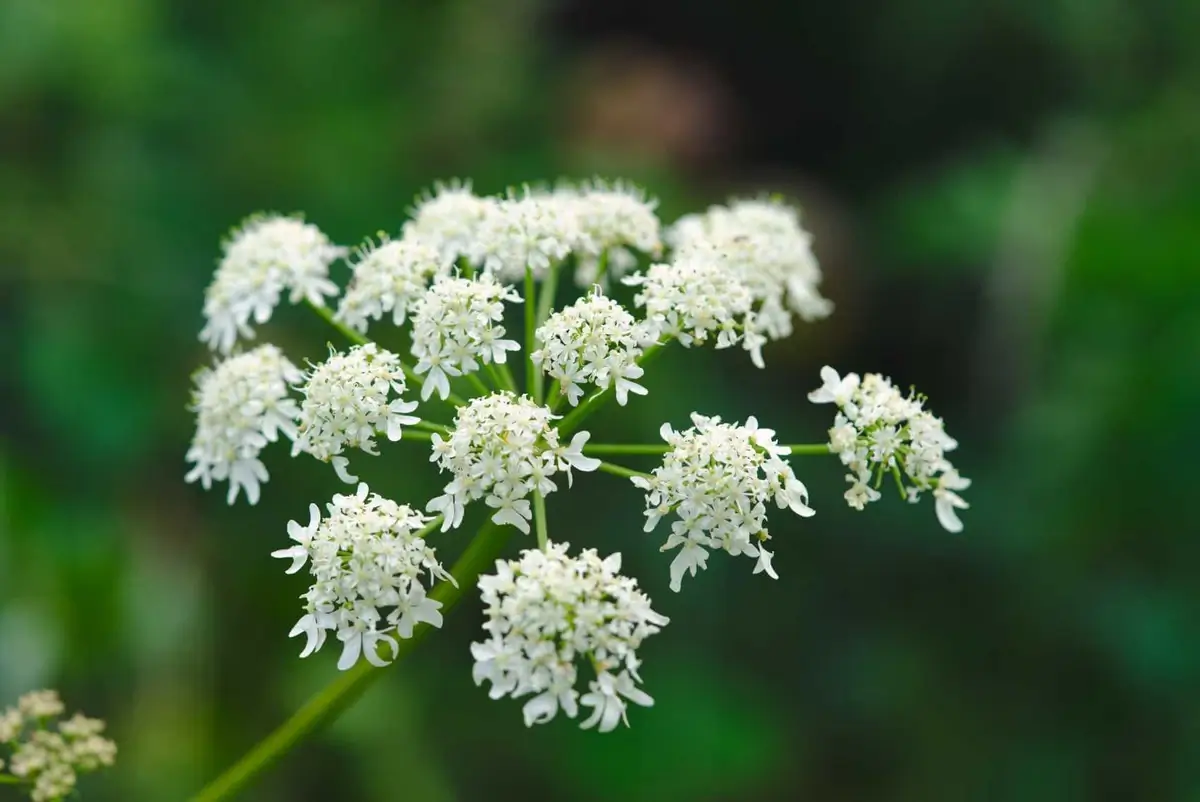
Image: petalrepublic.com
The Angelica plant, known scientifically as Angelica archangelica among other species, has been revered across Northern Europe for its purported mystical and healing properties. Ancient lore suggests the plant was named for its angelic associations, with one tale recounting an angel revealing the plant as a plague cure in a dream to a monk. The timing of its bloom, coinciding with the feast day of the Archangel Michael, further solidified its heavenly connections. Vikings are thought to have recognized its value, using Angelica on their expeditions to Eastern Europe.
Renowned for its large, starburst flowers, Angelica attracts a wide variety of pollinators with its species-specific floral scents. The plant contains furocoumarins, which can increase skin’s sensitivity to light but are also part of its medicinal arsenal. Beyond its folklore, Angelica was an essential component in medieval remedies and protective concoctions, such as Carmelite water, crafted to ward off witchcraft and disease. During the London Black Plague of 1665, it was a key ingredient in a purported cure.
Today, Angelica continues to be celebrated for its nutritional and medicinal benefits, containing essential minerals, vitamins, and coumarins with antioxidant effects. It’s been used to treat digestive ailments, enhance female health, and improve blood circulation. Culinary uses are equally versatile, with all parts of the plant enhancing both sweet and savory dishes.
22. Gas Plants Emit Flammable Gas
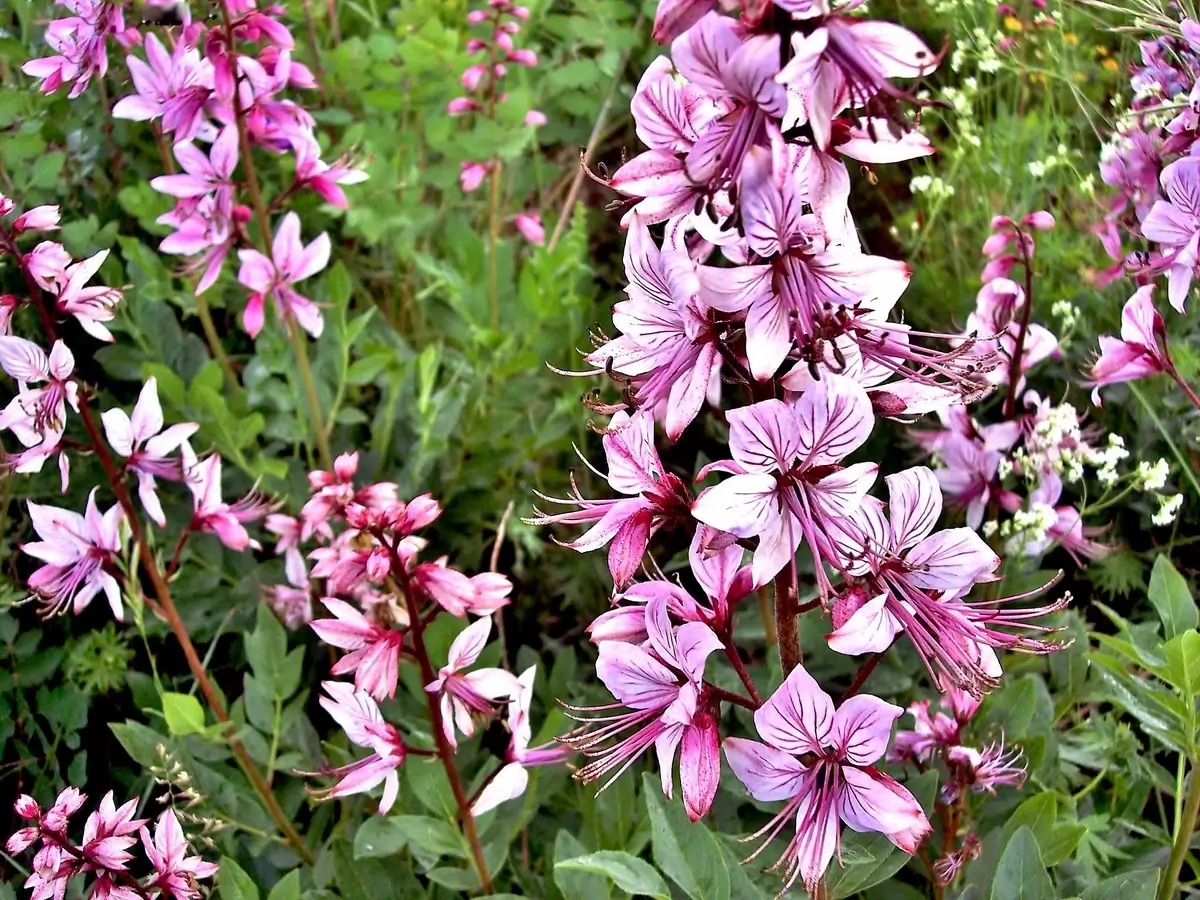
Image: Wikimedia Commons
The Gas Plant, or Dictamnus albus, is a fascinating species within the rue family known for its ability to emit a combustible gas. This herbaceous perennial, native to Eurasia, is also dubbed the burning bush due to its unique property of releasing an aromatic vapor from its flowers and leaves that can be ignited.
On warm, summer days, the gas plant exudes an oily substance rich in isoprene, a highly volatile organic compound. This oil has the remarkable ability to catch fire if exposed to a flame or if temperatures are sufficiently high, creating a brief flash of fire that does not harm the plant itself. This phenomenon has intrigued many, though its exact function remains a mystery. It’s speculated that the production of isoprene might serve as a heat stress protection mechanism for the plant.
23. Lucky Flowers: Clover, Peony, Lotus

Peony. Image: Pinterest
Across different cultures, certain flowers are believed to bring luck, prosperity, and spiritual enlightenment. The Clover, Peony, and Lotus are among these auspicious flora, each with its own unique significance.
Clover: Known for its association with St. Patrick and as a symbol of Ireland, the Clover, especially the rare four-leaf variety, is considered a sign of good luck. While the three leaves traditionally represent faith, hope, and love, finding a four-leaf clover is thought to bring extra luck.
Peony: In Chinese culture, Peonies are revered as the “king of flowers,” symbolizing wealth, prosperity, and good fortune. They are often used in traditional medicine, believed to bring balance and harmony. In Buddhism, peonies symbolize purity and enlightenment, often associated with spiritual awakening.
Lotus: The Lotus flower holds profound symbolism across various cultures. It represents purity, enlightenment, and spiritual awakening. In ancient Egypt, the Lotus was associated with rebirth and the sun. Buddhism sees it as a sign of purity, emerging clean from muddy waters. Hinduism associates the lotus with divine beauty and spiritual awakening, and in Chinese culture, it symbolizes purity and perfection.
24. Skeleton Flowers Become Transparent in Rain

Image: bhg.com
The Skeleton Flower (Diphylleia grayi) presents a captivating natural phenomenon. Under dry conditions, its white, rounded petals blend into the forest’s flora. However, upon contact with water, these petals undergo a stunning transformation, becoming almost crystal clear, earning it the moniker “skeleton flower.” Native to the moist, wooded mountainsides of Japan and China, this unique flower blooms from mid-spring to early-summer, showcasing small clusters of pearly white blossoms that turn translucent in the rain and revert to white once dry.
This magical transformation is not due to pigmentation but the flower’s unique cellular structure. The petals’ loosely packed cells contain air spaces that reflect light, making them appear white under dry conditions. When it rains, water fills these air spaces, matching the refractive index of the cells and allowing light to pass through with minimal reflection, rendering the petals transparent. Once the rain stops and the petals dry, they return to their opaque white color.
25. The Majestic Rafflesia Arnoldii: The World’s Largest Flower

Image: Pinterest
The Rafflesia arnoldii, often dubbed the “corpse flower” due to its pungent odor resembling decaying flesh, holds the title for the world’s largest flower. With blooms that can reach up to three feet in diameter and weigh as much as 15 pounds, this rare and remarkable species is a sight to behold. Native to the rainforests of Sumatra and Borneo, Rafflesia arnoldii is a parasitic plant, devoid of visible leaves, roots, or stems, relying entirely on its host plant for nutrition.
Discovered in the early 19th century by British surgeon Joseph Arnold and Stamford Raffles in Sumatra, its discovery was pivotal in the botanical world, leading to its naming in honor of its discoverers. The flower’s size and distinctive smell are not just for show; they play a critical role in attracting carrion flies for pollination, ensuring the continuation of its species.
Despite its fascinating nature, Rafflesia arnoldii faces threats from habitat destruction and is considered among the most endangered species of plants. Conservation efforts are challenging due to its unique life cycle and dependency on specific host plants, highlighting the importance of preserving its natural habitat for future generations to witness.
26. Orchids: Masters of Mimicry

Bee Orchid. Image: Wikimedia Commons
Orchids, with their alluring beauty, are not just a feast for the eyes but also a marvel of evolutionary innovation. These sophisticated plants have developed one of the most intricate pollination strategies found in the natural world, particularly through the art of mimicry. Orchids employ this strategy to attract pollinators, such as bees, wasps, and even flies, by mimicking the appearance, scent, and sometimes even the behavior of female insects.
Unlike many flowering plants that offer nectar as a reward to their pollinators, orchids often rely on deception. This strategy is especially prevalent in the genus Ophrys, commonly found in Europe, where orchid flowers mimic the physical appearance and pheromones of female bees or wasps. These flowers are so adept at this mimicry that male insects, mistaking the orchids for potential mates, attempt to copulate with them, inadvertently pollinating the plant in the process.
Australia is home to a remarkable variety of these deceptive orchids, with around 250 species across 10 genera employing sexual mimicry to lure their pollinators. The interaction between these orchids and their specific pollinators, primarily wasps from the Thynnine family, is a fascinating dance of attraction and deception. The orchids release chemical signals that mimic the pheromones of female wasps, which are irresistible to the male wasps. Upon landing on the flower, the structure of the orchid ensures that the wasp contacts the pollen. Some orchids, such as the hammer orchid, even use mechanical means to ensure effective pollination by flipping the wasp into the correct position to transfer pollen.
27. Dandelions: A Culinary and Nutritional Treasure

Image: Ralph / Pexels
Dandelions, often dismissed as mere weeds, are in fact a powerhouse of nutrition and have a storied history in culinary traditions, especially in the Mediterranean. Every part of the dandelion, from root to flower, is edible and packed with health benefits. The leaves, rich in vitamins A and C, offer a peppery addition to salads, stir-fries, and more.
These greens are not only a nutritious boost to smoothies but also a traditional ingredient in pies and salads. The dandelion flowers, with their subtle sweetness, can be transformed into syrups or jams, adding a unique flavor to pancakes, omelets, and risottos. For those looking for a caffeine-free alternative to coffee, roasted dandelion roots provide an earthy beverage option.
28. Middlemist’s Red: The World’s Rarest Flower

Image: facebook.com / Flower Best
The Middlemist’s Red camellia, a bloom of deep pink rather than true red, holds the title of the world’s rarest flower. Originally from China, this precious flower now exists in only two known locations globally: the Chiswick House & Gardens in the UK and the Treaty House in Waitangi, New Zealand. Named after John Middlemist, who brought the flower from China to London in 1804, this camellia has since vanished from its native land and is now a cherished rarity in its current homes.
Despite its name suggesting a reddish hue, the Middlemist’s Red is actually a deep pink color, growing on large evergreen shrubs that can reach up to 36 feet tall. These plants flower between January and March, bearing 2.4-3.9 inches in diameter blooms along their branches. The survival story of the Middlemist’s Red is as intriguing as its beauty, with one plant miraculously surviving World War II in England and the other’s journey to New Zealand shrouded in mystery.
Efforts to preserve this rare species have been cautious, with the Chiswick House & Gardens historically being selective about distributing clippings, thus ensuring the flower’s rarity and value are maintained. These efforts highlight the delicate balance between conservation and cultivation, aiming to prevent the extinction of this unique camellia variant.
29. The Flower of the Dead: Mexican Marigold
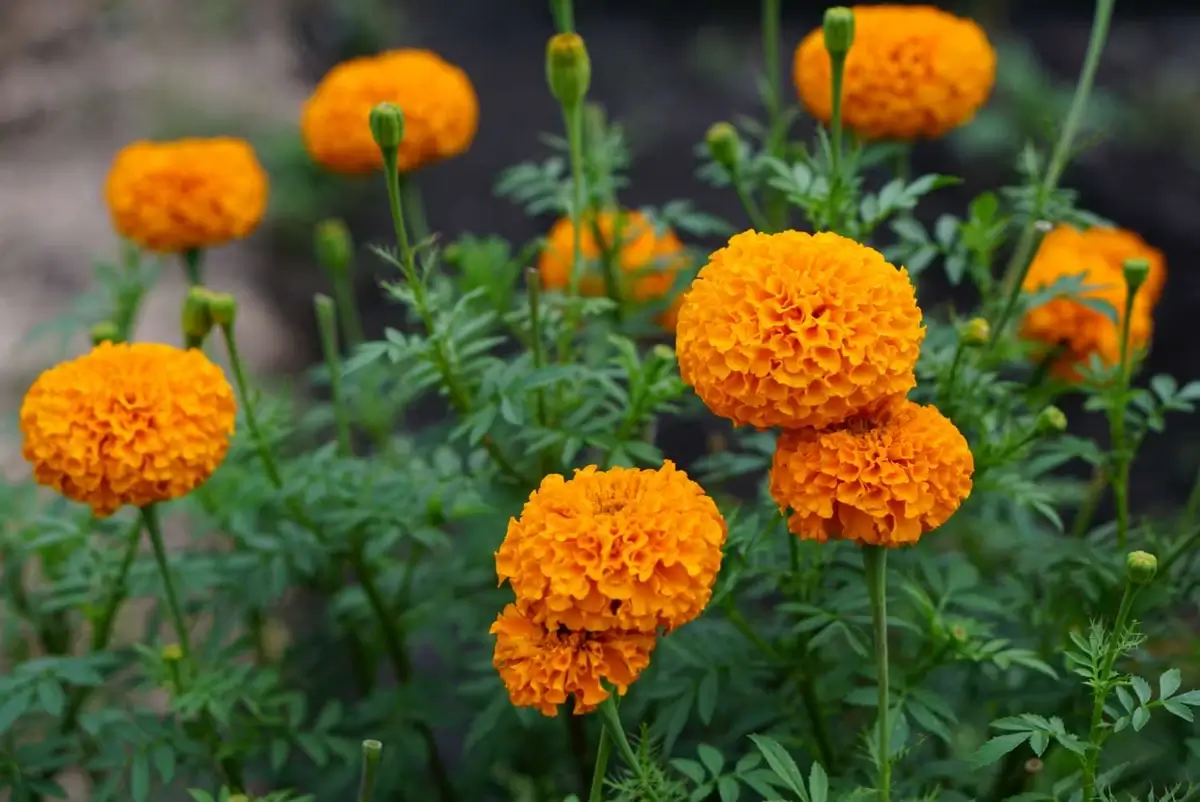
Image: thespruce.com
The Mexican Marigold, or Tagetes erecta, has deep roots in cultural traditions, particularly in Mexico’s Day of the Dead celebrations. Known locally as “La Flor de Muerto,” this vibrant flower serves as a bridge between the living and the spirits of the deceased. Its bright orange petals and potent fragrance are believed to guide the departed souls back to the earthly realm, ensuring they can join the festivities dedicated to their honor.
Historically, the use of the Mexican Marigold during Day of the Dead festivities dates back to pre-Columbian times. The Aztecs cultivated this flower, not only for its aesthetic appeal but also for its symbolic significance in rituals pertaining to life, death, and rebirth. Today, these marigolds adorn altars (ofrendas) and graves, creating a colorful and fragrant pathway for the souls. The tradition underscores the cyclical nature of life and death, while the marigold’s robust presence during these celebrations speaks to its enduring cultural significance.
30. The Enchantment of Bluebells: Fairies’ Delight
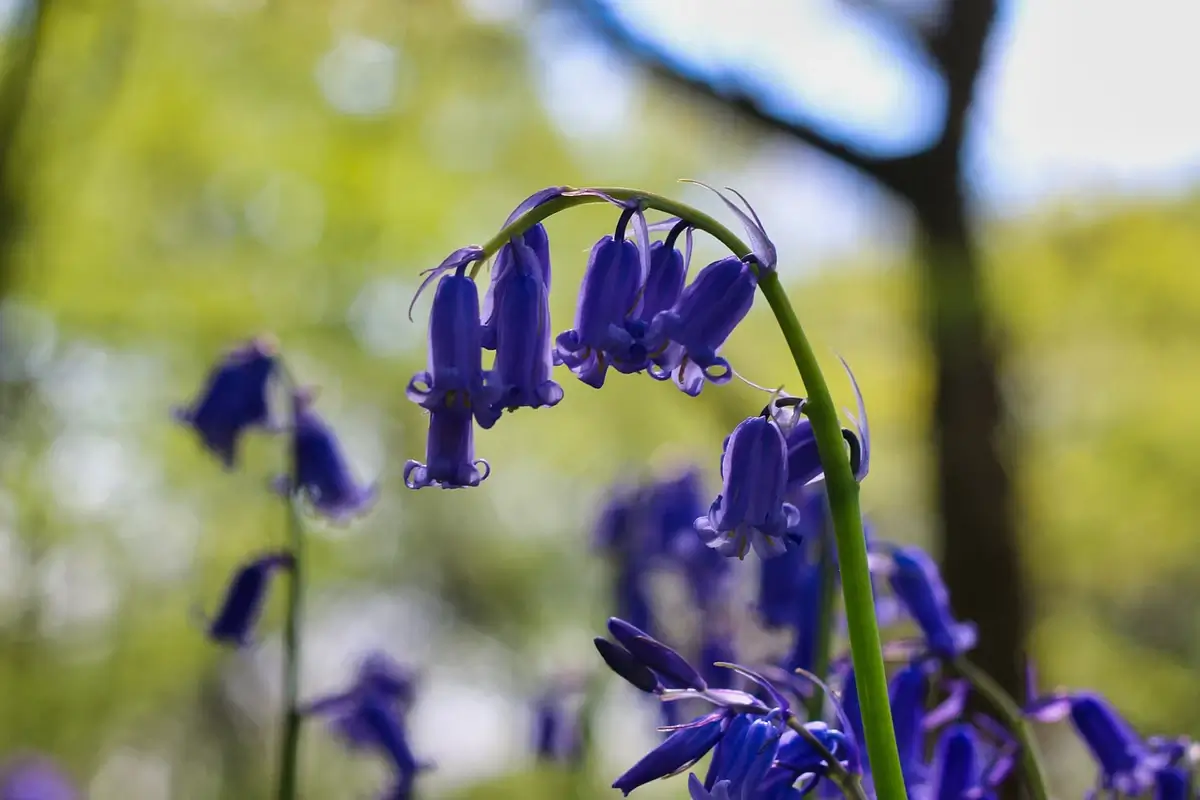
Image: Pinterest
The Bluebell, with its delicate bell-shaped blooms, is not just a herald of spring but a flower steeped in magical folklore. These enchanting flowers are closely associated with fairies and are believed to possess mystical properties. Walking into a woodland carpeted with bluebells is like stepping into a realm of fantasy, where the line between the natural and the supernatural blurs. The folklore suggests that bluebells ring to summon fairies to their gatherings. However, it is also said that only fairies can hear the bells ring, and for a human to hear them is an omen of bad luck.
The lore advises against picking or trampling upon bluebells as it is believed to anger the fairies who cast spells on these flowers. Moreover, stepping on or picking a bluebell could lead to being ‘pixie-led’ into endless circles or worse, fairy abduction for children.
Despite the warnings embedded in folklore, bluebells continue to captivate with their beauty and their association with fairies, adding a layer of mystique to these already beautiful flowers. If you are planning to visit a bluebell wood, remember to respect the blooms and perhaps, just maybe, you’ll be lucky enough to feel the magic in the air without actually hearing the fairy bells.
FAQ
What is the rarest flower?
The Middlemist Red is considered the rarest flower in the world. Originating from China, now it is only known to exist in two locations: a greenhouse in the UK and a garden in New Zealand.
What is the biggest flower?
The Rafflesia arnoldii produces the largest single bloom of any flowering plant. Found in the rainforests of Indonesia, the flower can measure up to 3 feet in diameter and weigh up to 15 pounds.
What is the tallest flower?
The Titan arum, or Amorphophallus titanum, is known for producing the tallest flower spike, which can reach over 10 feet in height. It is native to the rainforests of Sumatra, Indonesia, and is also noted for its strong, unpleasant odor.
What is the oldest flower in the world?
Montsechia vidalii is considered the oldest known flower in the world, dating back about 130 million years. Fossils found in Spain suggest it lived in shallow freshwater lakes and may have been similar to modern-day aquatic plants.
Which is smallest flower in the world?
The smallest flower in the world belongs to the plant Wolffia globosa, also known as watermeal. This duckweed species produces flowers that are less than 1 millimeter in size, making them virtually invisible to the naked eye.





